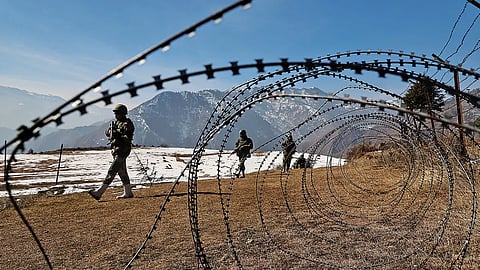Ghazal
Routes Of Grief: Two Translations
In spaces constituted from violence and silence like Kashmir, translation can emerge as a handy tool to create narrative communities within the world at large.
by Hamdam Kashmiri
In prison the blue liberty of
the wide sky –
Write such a prayer of
freedom for me.
Pale autumn rages
over life – heart, and body
Write the boundless legacy of
green leaves for me.
Silence sulks in my
doors and windows – open wide
Write a loud cry, a hushed
call for me.
Every minute is doused in
crimson-red twilight
Write henna in the eyes of
evening for me.
The lament I heard
on every bough, every meadow
Write it in the sands of
every desert for me.
Hamdam, how the fierce sun
bristles over me,
Write a quiet shade or
a cloud for me.
Fragrance of Death
by Saqi Faruqi
Separation
is the brook that feeds
the blood greased river of love
fidelity
has clung
to the coral branch of memory
heart, comfort and lovers
all crouch within the orbit of fear
The air reeks of stale kisses
Broken mirrors of dreams bleed in eyes
Sapphires of tears
Hide in the isles of hearts
A drizzle of sorrow spurts through the veins
But the seeds of sorrow will continue to fall
But people will continue to be separated
These are old sorrows
These seasons of union and separation
are old seasons
new-fangled sorrows have set out
to haggle with old sorrows
bloated lips sport a new blue
new seeds have begun
to be sown in heart
enemy skies crackle
with whispers of enemy planes
slums of stars lie torched
and only dark shadows
appear on the radar of empty eyes
We are mad from the fragrance of death
We drift in the black sea of destruction
Crouched inside the red submarines of hope.
From one shore to other
Hangs a pall of thick, bitter smoke
Earth, where is the magic of your fragrance?
(Originals in Urdu)
How does one think of routine grief and despair in Kashmir? Can translation offer a mechanism for it? Translation theorist Michael Cronin proposes that translation is “a way not only of thinking but of being and acting in the world” on a “few cosmopolitan ideals: a concern for freedom, openness to and tolerance of others, and a respect for difference”. Such a species of translation calls in effect for creation of narrative communities that harness the power of translation to subvert and transcend limitations of the language. In addition, it also brings the audience to a text that accommodates within itself archives of a routine life along with contestations of collective identity and action. In spaces constituted from violence and silence like Kashmir, translation can emerge as a handy tool to create narrative communities within the world at large, India in particular, by converting them to recognise concrete experience of a disenfranchised people.
ALSO READ: Kashmir: This Isn’t A Postcard Series
Hamdam Kashmiri’s poetry, for example, can be a suitable text for this prototype of this species of activist translation. The prayer for liberty and rejuvenation speaks of the routine climate of fear, terror and injury – both emotional and physical that the Kashmiri lives in on a daily basis, where a simple act as walking through a market is fraught with fatal danger, and even the sanctuary of home is not safe. Even as the pale autumn, which signifies pessimism and decay, is not a novel image, the pervasiveness of pessimism in the vale implies that the deepest yearnings are of are of vegetation, and for revival in spring that seems ever elusive.

Similarly, images of the bristling sun (used by Nasir Kazmi to great effect to indicate the trauma of Partition) and silent sulking in the windows are evocative signposts of memory that testify to the lived realities of Kashmir struggling with both literal heat (a worrying sense of global warming) as well as the heat of violence and crackdowns by the state. The silenced Kashmiri subject cries for an expression to express the inexpressible pain and trauma that haunts every space, and some shade of normalcy and quiet away from the din of the maddening world of dust and heat.
Similarly, Saqi Farooqi’s pertinent poem Fragrance of Death emerges as an inventory of the everyday trauma and grief in Kashmir. The poem evokes the feeling of estrangement and dissociation in survivors of violence, as well as in those left to pick up the pieces after the death of a near one. While survivors complain of flashbacks and intrusive thoughts represented by whispers of enemy planes in the skies, the slums of stars that lie torched testify to the complete extinguishing of hope and agency in usually parents or siblings of those who fall unwitting victims to ambush, blasts or cross firing.
The Urdu phrase: meri aankh ka taara (literally star of my eye) as an equivalent of the English phrase ‘apple of my eye’ points out to this strand of mourning. However, as the poem points out there seems to be no end in sight for relief for lips bloated with a new blue (indicative of a new bruise or form of injury: impairment, substance abuse, mental illness and loss of livelihood) as these are old seasons. However, since this history of impairment is neither new nor surprising, a sense of resignation and acceptance of this abnormality has set in as the Kashmiri subject desperately gropes for a way out from a thick pall of obfuscation. The plaintive cry: Earth, where is the magic of your fragrance? therefore, harks back to Hamidi Kashmiri’s poem: Write such a prayer for freedom (from grief, anguish and this routine of injury) for me. The two translations, therefore, bear out the maxim of Cronin and a way to express the inexpressible, thereby translating loss.
(Views expressed are personal)
ALSO READ
Huzaifa Pandit teaches literature at the Islamic university of science and technology, Kashmir